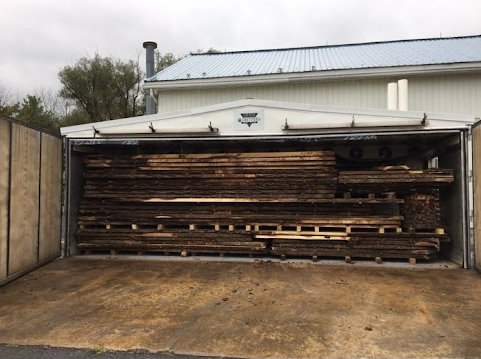Kiln Drying
Kiln Drying For Dimensional Stability
Once the lumber has been sawn it is stacked onto fluted drying sticks to prevent sticker stain in the drying process. Depending on the species and time of year most lumber is air-dried prior to going into one of our five Koetter Dry kilns for final drying. During warmer weather conditions, white woods such as Maple, Ash, Poplar, and Birch are dried shortly after stickering to maintain that bright white color.
The lumber is then dried in one of our five dry kilns to an equilibrium moisture content of 6% to 8%. The drying process is done at a rate that each species will give up the bound water freely. This rate of drying varies from species to species and also lengthens with the increased thickness of the lumber. Prior to removing the lumber from the kiln chamber it is conditioned. This process equalizes the moisture gradient between the core of the piece and the outside shell. This process produces lumber that is stress-free and nice to machine and works well. This is a must for fine woodworking projects.
Upon completion of drying, the lumber is removed from the kiln and is sorted for grade and width. At this time we mark the net board footage on the face of each piece. This is done for inventory control and also to let each customer know the net measurement of each piece they are purchasing. Items not stored in the retail bin are tallied and bundled for storage in our warehouse.

Frequently Asked Questions About Kiln Drying
How Long Does It Take Wood To Dry In A Kiln?
How long does it take wood to dry in a kiln? “We operate conventional dry kilns that remove the moisture in the wood at a steady rate, equal to what it will release naturally without causing drying defects. Each species of wood has a rate that it will give up that water. For instance, freshly sawn 4/4 Poplar and Pine can be dried in 10-14 days, and 4/4 Oak requires 28-30 days. Other species of 4/4 lumber fall in between those species for a time frame. There are other dry kilns that use different drying methods, such as vacuum dry kilns, and also a microwave. Those kilns dry lumber at a faster rate, but can also create more drying defects in the wood. Thicker lumber, such as 8/4 – 12/4, and Quarter and Rift sawn lumber will take considerably longer to kiln dry than 4/4. Air drying the thicker stock under Shade Dry tarps allows a good bit of the free water to be removed prior to it going into the kiln to be completely dried to 6%-8% moisture content. That helps to reduce kiln time and energy.
I Have Wood That Air Dried Outside. Should It Still Be Kiln Dried?
To best answer this question, it depends on where and what you plan to use it for. If it is for an exterior project, and it has acclimated to its surroundings, then you wouldn’t have to kiln dry it. If you are planning to make furniture, cabinets, millwork, or any project that will become part of an indoor area, then yes, kiln drying is important. All wood will dry down and eventually acclimate to its surroundings. Wood that is air-dried will eventually acclimate to the outdoor conditions. Air-dried wood that isn’t kiln dried prior to being used for an indoor project will still be in the northeast, have a moisture content of roughly 12-18% depending on the time of year. When that wood is used for furniture and brought into the home, during the winter it will shrink in width mostly, and acclimate to the lower humidity conditions of the home, which in February could get as low as 5%-6%. Kiln drying the wood prior to use will bring the moisture content down lower than where it will acclimate only by air drying. The cells of the wood will shrink and acclimate to the 5%-6% moisture that you will see during dry conditions in your home. Without being kiln-dried, the wood will get there at a controlled faster rate than air drying. The only way to get it to lower moisture content is to have it in your home for an extended period of time in the dryer conditions with air moving over the lumber allowing it to slowly acclimate which could take many months. Kiln drying also takes the wood fibers to a higher temperature than air drying alone, which when done correctly will stabilize the wood fibers and reduce their ability to absorb moisture more readily than when not kiln dried. Conditioning the wood fibers at the end of the drying cycle reduces drying tension in the wood fibers and makes the finished lumber nicer to work. That can’t be accomplished by air drying alone.
What Is The Largest Piece Of Wood You Can Kiln Dry?
We have 5 dry kilns that range in volume from 2000 – 6500 board feet capacity. The maximum length inside each kiln varies from 16’ to 25’ length. The width of the stacks they will handle ranges from 42”-60” width
What Does It Cost To Kiln Dry My Lumber?
We do limited custom kiln drying for customers. The challenge is matching up species and thicknesses that dry at the same rate for each kiln charge. If you are looking for a quote, please provide the following information so we can quote you. We need to know the quantity of material, the species, thickness, amount of air drying it has if any, or if possible the current moisture content. Based on that information we can quote you based on the time it takes to properly dry the material, and the time frame based on loads that we are processing that it will dry at a like rate.
